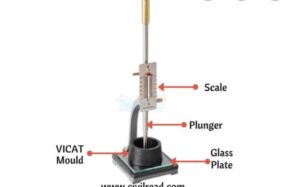Test Of Cement – Consistency Test
Test Of Cement – Consistency Test
 |
| Test Of Cement – Consistency Test apparatus |
Purpose Determination Of Consistency For Cement
The test Of Cement – Consistency Test Is Done To Find Out The Consistency Of Cement Which Permits The Vicat apparatus Plunger To Penetrate to a point 5 to 7 mm from the bottom of the vicat mould when tested. Procedure to determine the quantity of water required to produce a cement paste of standard consistency is Explained As In Following Steps.
Reference Code For Determination Of Consistency Of Cement
Determination Of Consistency Of Cement Is Done According To IS Code 4031 (Part 4).
Required Apparatus For Determination Of Consistency Test
1- Vicat Apparatus With Mould
The vicat apparatus consists of a frame having a movable rod with a cap at one end and at the other end any one of the following attachment, which are interchangeable.
 |
| Test Of Cement – Consistency Test apparatus |
2- Needles
There Two Types Of Needle Are Required For First For Initial Setting Time And Second For Final Setting Time,
For Initial Setting Time- The needle is having a cross sectional area of 1mm2. The end of the needle is flat.
For Final Setting Time- The needle is circular having a cross sectional area of 1mm2. The needle is fitted with a metal attachment. The end of the needle projects beyond the cutting edge of the hollowed out metal attachment.
3- Balance
Electric Or Any Other Balance Is Required With Highly Precision To Measure The Weight Of Cement,
 |
| Electric Balance |
4- Plunger for Standard Consistency Test
It is made of polished brass 10 ± 0.05mm in diameter with a projection at the upper end for insertion into the movable rod. The lower end is flat.
5- Graduated Scale
Graduated scale is 40mm in length and the smallest division of scale is 1mm.
6- Vicat Mould
The vicat mould is in the foam of a frustum of a cone having an internal diameter of 60+/- 0.5 mm at the top, 70 +/- 0.5 mm at the bottom and height 40 +/_ 0.5 mm.
The split type vicat mould is used as an alternative to single mould. This mould consist of a split ring having an internal diameter 80+/- 0.1mm and a height 40+/_0.5mm. A non-porous base plate is provided. The split mould is provided with a suitable clamping ring.
7- Standard Weights
8- Gauging Trowel
9- Non Porous plate
Detailed Standard Operating Procedure (Test Of Cement – Consistency Test)
> Take 500 gms Of Cement.
> Add 24 % Water Into Cement.
> The Paste Must Be Prepared In A Standard Manner And Filled Into Vicat Mould Within 3 To 5 Minutes.
> After Filling The mould Shake The Mould To Expel Air.
> A standard Plunger is Brought Down To Touch The Surface of the Paste In The test Block And Quickly Released Allowing it To Sink Into Paste By It’s Own Weight.
> Take The Reading And Note Down It.
> Conduct The Second Trial With % Of Water At 25 And Take The Reading.
> Conduct Similar Trials With Higher W/C Ratio Till Plunger Penetrates For A Depth Of 33 to 35 mm From The Top.
> The Percentage Of Water At Which Penetration 33 to 35 mm From To Top Or 5 to 7 mm From Bottom Is A standard Consistency.
Observation And Calculations
1- Weight of cement taken (g) = _________
2- Initial percentage of water added to cement = __________
3- Quantity of water added to cement =_______
Important Precaution To Be Taken
1- The test should be conducted at room temperature 27oC +/- 2oC .
2- There should be no vibration on the working table.
3- The plunger should be cleaned during every repetition.
4- The time of gauging should not be less than 3 minutes and not more than 5 minutes.
2- There should be no vibration on the working table.
3- The plunger should be cleaned during every repetition.
4- The time of gauging should not be less than 3 minutes and not more than 5 minutes.



